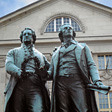GOETHE RESIDENCE HOUSE - WEIMAR
Classicism, War and the Faustian Deal
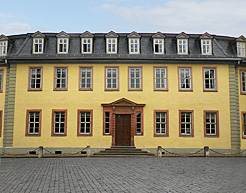 Although Johann Wolfgang von Goethe lived in a few places in his life, Frankfurt, where he was born and first began his law practice, Leipzig where he studied law at the university and got the inspiration for Faust from his visits to the local student’s wine pub hangout (see Auerbach’s Keller), and Italy, where he gained his love for classical statuary, he lived for much of his adult life in Weimar. There is a Goethe House in Frankfurt where he was born with its own museum (see Goethe House Frankfurt). The house in the heart of Weimar is where he lived for fifty years from 1792 until his death in 1832.
Although Johann Wolfgang von Goethe lived in a few places in his life, Frankfurt, where he was born and first began his law practice, Leipzig where he studied law at the university and got the inspiration for Faust from his visits to the local student’s wine pub hangout (see Auerbach’s Keller), and Italy, where he gained his love for classical statuary, he lived for much of his adult life in Weimar. There is a Goethe House in Frankfurt where he was born with its own museum (see Goethe House Frankfurt). The house in the heart of Weimar is where he lived for fifty years from 1792 until his death in 1832.
Goethe in Weimar
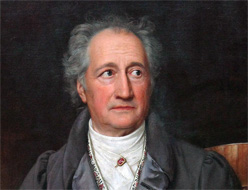 Goethe’s law practice was short, first working for his father in Frankfurt, but he soon began his writing with a drama based on the colorful biography of a noble turned highwayman during the German Peasant’s War Götz von Berlichingen (see Castle Hornburg), best known as the knight with the iron hand, a real person (turned into a Japanese manga and the inspiration for the Jamie Lanister character in Game of Thrones). Goethe became literary celebrity by the age of 25 in 1774 with the publishing of the book which would bring him world fame, The Sorrows of Young Werther.
Goethe’s law practice was short, first working for his father in Frankfurt, but he soon began his writing with a drama based on the colorful biography of a noble turned highwayman during the German Peasant’s War Götz von Berlichingen (see Castle Hornburg), best known as the knight with the iron hand, a real person (turned into a Japanese manga and the inspiration for the Jamie Lanister character in Game of Thrones). Goethe became literary celebrity by the age of 25 in 1774 with the publishing of the book which would bring him world fame, The Sorrows of Young Werther.
In 1775, the Duke Karl August of Saxe-Weimar-Eisenach, himself only 18, invited the lawyer/author to Weimar. He became a close confidant of the royal, and served in a succession of government offices. Goethe is known as a giant of German literature, but his day job was mostly as a government minister.
In 1779, Goethe was named to head the War Commission of the Grand Duchy of Saxe-Weimar, and played a distant role in the American War for Independence, involved in conscripting soldiers from Saxony to serve the German expeditionary forces, colloquially known as Hessians because most of them came from Hesse. He also did duty on the Mines and Highways commissions. In 1782, he was named as Chancellor of the Exchequer to fill a vacancy. To honor the position, he was knighted by his benefactor, adding the von Goethe to his name, and the duke bought the house on the Frauenplan of Weimar and gifted it to his prime minister.
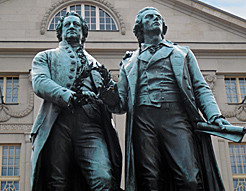 Goethe advised the duke at the Battle of Valmy against France when the Prussians under the Duke of Brunswick marched on Paris in a failed invasion following the revolution in September of 1792. And he was at the duke’s side at the Siege of Mainz (see Mainz Citadel ) as a military observer. In 1794, back in Weimar, a letter from Friedrich Schiller (best known for his drama of Swiss revolutionary apple shooting archer Wilhelm Tell) which offered friendship after an earlier testy acquaintance (see Schiller House Weimar). For the next six years they became close friends until Schiller’s early death in 1805, but they are now so connected and memorialized in Weimar as the founders of Weimar Classicism, their statue together stands in the main square, joined forever together in art and souvenirs.
Goethe advised the duke at the Battle of Valmy against France when the Prussians under the Duke of Brunswick marched on Paris in a failed invasion following the revolution in September of 1792. And he was at the duke’s side at the Siege of Mainz (see Mainz Citadel ) as a military observer. In 1794, back in Weimar, a letter from Friedrich Schiller (best known for his drama of Swiss revolutionary apple shooting archer Wilhelm Tell) which offered friendship after an earlier testy acquaintance (see Schiller House Weimar). For the next six years they became close friends until Schiller’s early death in 1805, but they are now so connected and memorialized in Weimar as the founders of Weimar Classicism, their statue together stands in the main square, joined forever together in art and souvenirs.
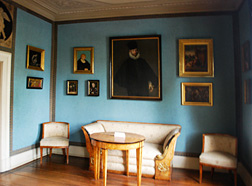 In a chilling incident at the house in 1806, Goethe had taken up housekeeping with his long time mistress Christiane Vulpius. On October 13th, the Napoleon’s army, sweeping across Germany, surrounded Wiemar and a handful of marauding French soldiers invaded the house. He at first greeted them as a dignified figure, but later they broke into Goethe’s bedroom with bayonets, but Christiane rallied several townspeople who had taken refuge and chased them back, barricading the kitchen and cellar from the pillagers, until the army moved on. Six days later on October 19, Goethe finally married her in a quiet ceremony at the Jakobskirche.
In a chilling incident at the house in 1806, Goethe had taken up housekeeping with his long time mistress Christiane Vulpius. On October 13th, the Napoleon’s army, sweeping across Germany, surrounded Wiemar and a handful of marauding French soldiers invaded the house. He at first greeted them as a dignified figure, but later they broke into Goethe’s bedroom with bayonets, but Christiane rallied several townspeople who had taken refuge and chased them back, barricading the kitchen and cellar from the pillagers, until the army moved on. Six days later on October 19, Goethe finally married her in a quiet ceremony at the Jakobskirche.
Shortly after this episode Goethe’s most famous work made its first appearance. The epic drama Faust, was completed in stages and only published in its full length after his death, but the first volume was published in 1808. It created a sensation and gained recognition as a subject for opera. The first musical interpretation, by Louis Spohr, appeared in 1814 and was later the inspiration for composers Schumann and Berlioz, and symphonic works by Liszt (see Liszt House), Wagner, and Mahler and the “Faustian Bargain” of selling one's soul to the devil for power over the physical world, became a literary mainstay.
Goethe died in Weimar in 1832 of apparent heart failure. His last words, according to his doctor were, “More Light!” (Mehr Licht!). Who he was talking to and whether the devil had come for him, only death knows. He is buried next to his friend Schiller in the Ducal Vault at Weimar's Historical Cemetery.
Goethe Residence House
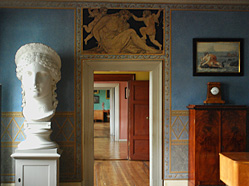 The house was first built in 1709 and Goethe first took up lodging as a tenant on the 1st of June 1782. After he was granted the house permanently, Goethe had the building reconstructed to his own designs based on his ideology and love of the classic form. He had the wide stair case and hallways constructed with niches for sculptures and mounted stucco friezes. The section of the house which faces the town contains the elegant living, social and collection rooms, while the back of the house with the working areas looks out on garden.
The house was first built in 1709 and Goethe first took up lodging as a tenant on the 1st of June 1782. After he was granted the house permanently, Goethe had the building reconstructed to his own designs based on his ideology and love of the classic form. He had the wide stair case and hallways constructed with niches for sculptures and mounted stucco friezes. The section of the house which faces the town contains the elegant living, social and collection rooms, while the back of the house with the working areas looks out on garden.
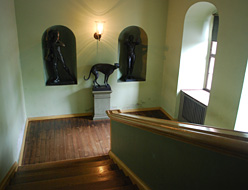 Entering the house from a narrow courtyard, on the first level are stations where you can linger and read some of Goethe’s work, thought they could use a little more light on gloomy days. Then, climb the stairway with its low risers made for an easy climb and where Goethe first confronted the French soldiers. The niches for statuary on the stair entry offer an introduction to his love of classicism.
Entering the house from a narrow courtyard, on the first level are stations where you can linger and read some of Goethe’s work, thought they could use a little more light on gloomy days. Then, climb the stairway with its low risers made for an easy climb and where Goethe first confronted the French soldiers. The niches for statuary on the stair entry offer an introduction to his love of classicism.
The eighteen rooms on the self-guided tour present original furniture and other belongings from Goethe’s life in the house, with personal memorabilia and numerous objects from Goethe’s extensive collection of hand drawings, paintings, sculptures, bronzes, majolica, coins and medallions. The display of the collection mostly matches their presentation during the last years of the his life. The tour ends with the main attraction of Goethe’s study with its authentic furnishings, the desk where he worked, and his private library.
The Garden
The garden of the house was mostly looked after by Goethe’s mistress, now wife, Christiane, principally supplying fresh fruit and vegetables. Around 1794, Goethe engaged in botanical experiments using some of the beds for systematic planting of specimens. In 1817, the garden was expanded eastward by the acquisition of the so-called “Treuter Garden” when Goethe acquired the garden house next door to store his mineral collection. The garden is kept today as it was in 1820s, with the former vegetable beds now replaced by lawns.
Goethe National Museum Exhibitions
The Goethe Residence is in the same building as the Goethe National Museum with ongoing exhibitions on Goethe’s life and legacy. The ticket desk is situated between separate entrances, and individual tickets or combined.
Visiting Goethe Residence Weimar
Open hours are Tuesday to Sunday (closed Monday) 9:30 am to 6 pm in summer months from the end of March to end of October and 9:30 am to 4 pm winter months November to March. Admission for adults is €12.50, Concession (Seniors, Disabled) €9, Student Age (16-20 years) €4, youth under 16 years free. There is an audioguide available in multiple languages. © Bargain Travel EuropeFind best hotel and vacation deals in Weimar on TripAdvisor
These articles are copyrighted and the sole property of Bargain Travel Europe and WLPV, LLC. and may not be copied or reprinted without permission.
See Also:
BACH HOUSE MUSIC MUSEUM - EISENACH
LEOPOLD MOZART BIRTHHOUSE - AUGSBURG
BAUHAUS & MASTER HOUSES - DESSAU

